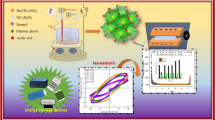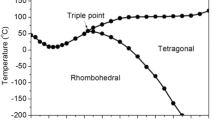Abstract
Of all the piezoelectric ceramics, lead titanate (PbTiO3) has an important place as an electromechanical transducer. In the present article PbTiO3 synthesized by sol–gel technique and microwave processed is presented. The sintered PbTiO3 is found to be of high density. The sintered PbTiO3 crystal structure and crystallinity confirmed by powder X-ray diffraction and sample weight loss and decomposition investigated by thermal analysis. Prepared PbTiO3 functional groups confirmed by FT-IR spectrum and phase formation analyzed by Raman spectra. Sample spherical morphology confirmed by high-resolution scanning electron microscopy (HRSEM) and transmission electron microscopy (TEM). The particle size found to be 77 nm from TEM. The variation of dielectric constant and ac conductivity with temperature and frequency of PbTiO3 are investigated. The value of σdc is found to be 1.767 × 10−2 S/cm at transition temperature using the Nyquist plot. The ferroelectric hysteresis loop and piezoelectric coefficient d33 confirm the ferroelectric and piezoelectric nature of the PbTiO3 (PT).
Graphical abstract











Similar content being viewed by others
References
Chaudhari VA, Bichile GK (2013) Synthesis, structural, and electrical properties of pure PbTiO3 ferroelectric ceramics, smart. Mater Res 2013:1–9
Zekria D, Glazer AM, Shuvaeva V, Dec J, Miga S (2004) Research papers birefringence of lead titanate (PbTiO3) research papers. J Appl Crystallogr 37:551–554. https://doi.org/10.1107/S0021889804008921
Lanki M, Nourmohammadi A, Mohammad S, Feiz H, Rahmati E (2016) Processing research application of lower temperature for crystallization of PbTiO3 nanopowders by the sol-gel method. J Ceram Process Res 17:394–400
Sharma PK, Ounaies Z, Varadan VV, Varadan VK (2014) Dielectric and piezoelectric properties of microwave sintered PZT. Smart Mater Struct 10:878–883
Jiping Cheng RR, Fang Yi, Agrawal DK (1994) Microwave synthesis of lead-barium titanate. Mater Res Soc 347:513–518
Longo E, Leite ER (2016) Dielectric characterization of microwave sintered lead zirconate titanate ceramics. Ceram Int 42:14423–14430. https://doi.org/10.1016/j.ceramint.2016.06.035
Chilibon I, Igreja R, Dias CJ (2005) Ultrasound role in sol-gel processing of PbTiO3 ceramics. J Optoelectron Adv Mater 7:2727–2735
Lee C, Tai N, Sheu H, Chiu H, Hsieh S (2006) The formation of perovskite PbTiO3 powders by sol – gel process. Mater Chem Phys 97:468–471. https://doi.org/10.1016/j.matchemphys.2005.08.048
Hernandez-sanchez BA, Chang K, Scancella MT, Burris JL, Kohli S, Fisher ER, Dorhout PK (2005) Examination of size-induced ferroelectric phase transitions in template synthesized PbTiO3 nanotubes and nanofibers. Chem Mater 2:5909–5919. https://doi.org/10.1021/cm0493896
Wang J, Pang X, Akinc M, Lin Z (2010) Synthesis and characterization of perovskite PbTiO3 nanoparticles with solution processability. J Mater Chem 20:5945–5949. https://doi.org/10.1039/c0jm00270d
Lanki M, Nourmohammadi A, Feiz MH (2012) Electrophoretic growth of lead titanate nanotubes, in: Appl. Ferroelectr. Held Jointly with 2012 Eur. Conf. Appl. Polar Dielectr. 2012 Int. Symp Piezoresponse Force Microsc. Nanoscale Phenom. Polar Mater. (ISAF/ECAPD/PFM), 2012 Intl Symp, pp. 1–4
Niranjan Sahu SP, Kar M (2010) Rietveld refinement,microstructure and electrical properties of PbTiO3 ceramic materials. Arch Phys Res 1:75–87
Kwok-Ho Lam HL-WC, Kun Li (2014) Department, lead magnesium niobate – lead titanate fibres by a modified sol – gel method a modified sol – gel method. Mater Res Bull 40:1955–1967. https://doi.org/10.1016/j.materresbull.2005.05.024
Lanki M, Nourmohammadi A, Feiz MH (2012) Lead partitioning in sol-gel derived lead titanate nanopowders, in: Appl. Ferroelectr. Held Jointly with 2012 Eur. Conf. Appl. Polar Dielectr. 2012 Int. Symp Piezoresponse Force Microsc. Nanoscale Phenom. Polar Mater. (ISAF/ECAPD/PFM), 2012 Intl Symp, pp. 3–6
Vijayalakshmi R, Rajendran V (2012) Effect of reaction temperature on size and optical properties of NiTiO3 nanoparticles. E-J Chem 9:282–288
Yuvaraj RKSS, Nithya VD, Saiadali Fathima. K, Sanjeeviraja. C, Kalai Selvan. G, Arumugam S (2013) Investigations on the temperature dependent electrical and magnetic properties of NiTiO3 by molten salt synthesis. Mater Res Bull 48:1110–1116. https://doi.org/10.1016/j.materresbull.2012.12.001
Zarel K, Sadjadi MS, Enhessari M, Khanahmadzadeh S (2009) Synthesis and characterization of PbTiO3 nanopowders by citric acid gel method. J Phys Theor Chem 6:9–12
Ohsaka T, Izumi F, Fujiki Y (1978) Raman spectrum of anatase, TiO. J Raman Spectrosc 7:321–324
Fujii Y, Noju M, Shimizu T, Taniguchi H, Itoh M, Nishio I (2014) Ferroelectrics Raman tensor analysis of crystalline lead titanate by quantitative polarized spectroscopy. Ferroelectrics 462:37–41. https://doi.org/10.1080/00150193.2014.890470
Manohar A, Krishnamoorthi C (2017) Site selective Cu 2+ substitution in single crystal Fe3O4 biocompatible nanospheres by solvothermal reflux method. J Cryst Growth 473:66–74. https://doi.org/10.1016/j.jcrysgro.2017.05.013
Das PR, Choudhary RNP, Samantray BK (2007) Diffuse ferroelectric phase transition in Na2 Pb2Sm2W2Ti4Nb4O30 ceramics. Mater Chem Phys 101:228–233
Brahma S, Choudhary RNP, Thakur AK (2005) AC impedance analysis of LaLiMo2O8 electroceramics. Phys B Condens Matter 355:188–201
Jacob R, Nair HG, Isac J (2015) Impedance spectroscopy and dielectric studies of nanocrystalline iron doped barium strontium titanate ceramics. Process Appl Ceram 9:73–79
Thakur S, Rai R, Bdikin I, Valente MA, Pradesh H, De Santiago CU (2016) Impedance and Modulus spectroscopy characterization of Tb modified Bi0.8A0.1Pb0.1Fe0.9Ti0.1O3 ceramics. Mater Res 19:1–8
Jordan TL, Langley N (2001) Piezoelectric ceramics characterization. Institute for computer applications in science and engineering (ICASE-2001-28), Hampton, Virginia
Guo Q, Cao GZ, Shen IY (2013) Measurements of piezoelectric coefficient d33 of lead zirconate titanate thin films using a mini force hammer. J Vib Acoust 135:1–9. https://doi.org/10.1115/1.4006881
Saito Y (1995) Measurements of complex piezoelectric d33 constant in ferroelectric ceramics under high electric field driving. J Appl Phys 34:5313–5319
Author information
Authors and Affiliations
Corresponding author
Ethics declarations
Conflict of interest
The authors declare that they have no conflict of interest.
Rights and permissions
About this article
Cite this article
Pavithra, C., Madhuri, W. Dielectric, piezo and ferroelectric properties of microwave sintered PbTiO3 synthesized by sol–gel method. J Sol-Gel Sci Technol 85, 437–445 (2018). https://doi.org/10.1007/s10971-017-4565-y
Received:
Accepted:
Published:
Issue Date:
DOI: https://doi.org/10.1007/s10971-017-4565-y




